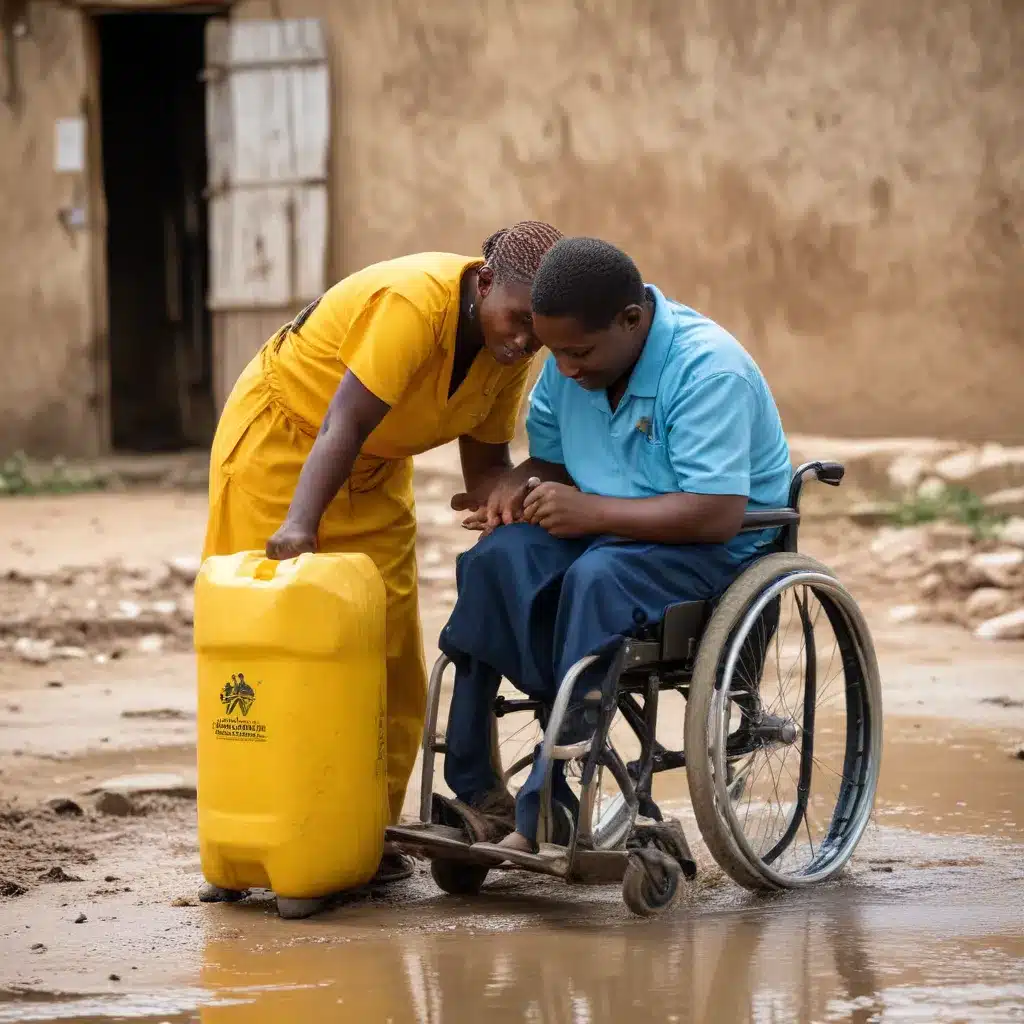
Understanding the Unique Needs of People with Disabilities in Emergencies
Emergencies and disasters can be particularly challenging for people with disabilities, as they often face additional barriers to accessing essential water, sanitation, and hygiene (WASH) services. Whether it’s a natural disaster, a conflict, or a public health crisis, people with physical, sensory, cognitive, or psychosocial disabilities may struggle to navigate unfamiliar environments, communicate their needs, or find appropriate assistive devices.
Mobility Challenges: Individuals relying on wheelchairs, walkers, or other mobility aids may have difficulty evacuating quickly or accessing emergency shelters and WASH facilities. Stairs, narrow doorways, and uneven terrain can pose significant obstacles.
Communication Barriers: Those with hearing, speech, or vision impairments may have trouble comprehending emergency instructions or signage, leading to confusion and potential isolation.
Medication and Medical Needs: Disruptions to power, transportation, and supply chains can jeopardize access to life-sustaining medications, equipment, and specialized care, putting the health and well-being of people with disabilities at great risk.
Assistive Technology Dependence: The loss or damage of essential assistive devices, such as hearing aids, canes, or prosthetic limbs, can severely limit a person’s independence and ability to safely navigate emergency situations.
Embracing an Inclusive Approach to WASH Emergency Response
To ensure that the unique needs of people with disabilities are addressed during emergencies, a comprehensive and inclusive approach to WASH response and recovery efforts is crucial. By incorporating the principles of universal design and actively engaging with the disability community, we can build more resilient and equitable emergency systems.
Accessible WASH Infrastructure
During the planning and implementation of emergency WASH facilities, it is essential to consider accessibility from the outset. This includes:
- Barrier-free Design: Ensuring that toilets, handwashing stations, and other WASH amenities are accessible to individuals using wheelchairs, walkers, or other mobility aids, with ample space for maneuvering and appropriate grab bars or handrails.
- Inclusive Communication: Providing clear, multi-sensory signage that can be easily understood by people with visual, hearing, or cognitive impairments, such as using pictograms, braille, and auditory cues.
- Backup Power and Assistive Technologies: Equipping emergency WASH facilities with backup power sources and charging stations to maintain the functionality of essential assistive devices, such as electric wheelchairs or hearing aids.
Disability-Inclusive Disaster Preparedness
Effective emergency preparedness must involve close collaboration with the disability community. This includes:
- Participatory Planning: Engaging people with disabilities and their representative organizations in the design and implementation of emergency plans, ensuring their unique needs and perspectives are incorporated.
- Tailored Emergency Kits: Encouraging individuals with disabilities to assemble personalized emergency kits that include essential medications, spare assistive devices, and any specialized supplies they may require.
- Evacuation Support: Developing and practicing emergency evacuation procedures that address the specific needs of people with disabilities, with provisions for accessible transportation and dedicated personal assistance.
Capacity Building and Disability-Inclusive Training
Equipping emergency responders and WASH service providers with the knowledge and skills to support people with disabilities is crucial. This involves:
- Disability Awareness Training: Educating emergency personnel on the diverse needs and experiences of people with disabilities, including communication strategies, assistive technology, and appropriate assistance techniques.
- Inclusion Mainstreaming: Integrating disability-inclusive practices into standard emergency response and WASH service delivery protocols, ensuring that accessibility is a core consideration, not an afterthought.
- Community Partnerships: Fostering strong collaborations with disability organizations and networks to leverage their expertise and facilitate seamless coordination during emergencies.
Empowering Communities through Inclusive WASH Advocacy
Advancing inclusive WASH emergency response requires a multi-faceted approach that empowers people with disabilities to advocate for their rights and participate actively in shaping more equitable and resilient systems.
Strengthening Disability Rights and Legislation
Advocating for the implementation and enforcement of disability-inclusive policies, laws, and standards can help enshrine the rights of people with disabilities in emergency preparedness and WASH service delivery. This includes:
- Aligning with International Frameworks: Ensuring that national and local emergency management strategies are aligned with the United Nations Convention on the Rights of Persons with Disabilities (CRPD) and other relevant global frameworks.
- Championing Inclusive WASH Legislation: Advocating for the inclusion of specific provisions for people with disabilities within WASH-related laws and regulations, such as accessibility requirements and emergency response protocols.
Community-Led Monitoring and Accountability
Engaging people with disabilities and their representative organizations in the monitoring and evaluation of emergency WASH services can help ensure that the needs of the disability community are being met. This includes:
- Participatory Assessments: Involving people with disabilities in the design and implementation of WASH needs assessments, service evaluations, and impact analyses to capture their unique perspectives and experiences.
- Feedback Mechanisms: Establishing accessible and responsive feedback channels that enable people with disabilities to voice their concerns, share their experiences, and contribute to the continuous improvement of WASH emergency response.
Inclusive Capacity Building and Empowerment
Empowering people with disabilities to become active participants in the design, implementation, and monitoring of inclusive WASH emergency response is crucial. This involves:
- Peer-to-Peer Learning: Facilitating knowledge-sharing and skill-building opportunities among people with disabilities, fostering the development of self-advocacy and community-led initiatives.
- Leadership Development: Supporting the emergence of disability champions and advocates who can effectively represent the interests of the disability community in WASH emergency planning and decision-making processes.
- Collaboration with Disabled People’s Organizations: Partnering with local, national, and international disabled people’s organizations (DPOs) to leverage their expertise, networks, and collective voice in advocating for inclusive WASH emergency response.
By embracing an inclusive and participatory approach to WASH emergency response, we can ensure that people with disabilities are not left behind and that their unique needs and perspectives are reflected in the design and implementation of resilient, equitable, and accessible systems. Together, we can build a future where no one is left behind, even in the face of emergencies and disasters.

